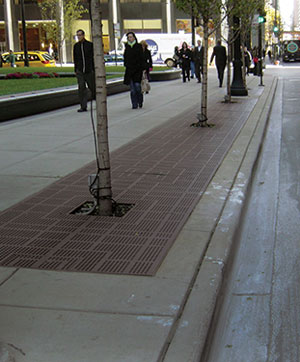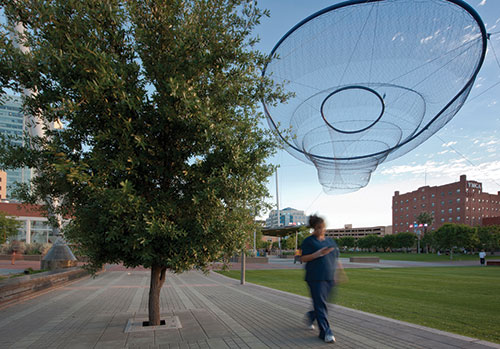Design Options for Greening Urban Environments
Pervious Flexible Pavement System Standards
A grass pervious flexible pavement system is best used for light to moderate vehicular use and to reinforce turf. It helps to filter and treat stormwater pollution, reduce heat island effect, and enhance tree growth in parking areas. Since porous pavers drain more rapidly than regular pavers, more water must be applied during the first year after initial seeding to ensure a solid stand of grass. Chemicals cannot be used to remove snow from a grass pervious flexible pavement as these chemicals will degrade the grass and can rapidly leach into the ground water. As with any type of porous pavement, there are also slope restrictions with the use of pervious flexible pavement systems, which include the following:
- 5 percent maximum slope for fire lanes
- 8 percent maximum slope for parking areas
- 15-20 percent slopes for trails and walkways
Pervious flexible paving systems that involve the development of a lawn/grass help to recharge groundwater, reduce stormwater runoff volume, capture suspended solids, clean hydrocarbon drips and pollutants, and protect the grass root zone from compaction so a healthy lawn can be maintained.
A gravel pervious flexible pavement system can be used for parking aisles and bays, ADA and multiple use trails, service and access drives, fire lanes, driveways, RV parking, boat and truck storage, boat ramps, and high-use pedestrian areas. A gravel pervious flexible pavement system has unlimited use in lower-speed vehicular traffic. It can also be used for ADA multiple use trails. The benefits include providing a pervious load-bearing surface, reducing heat island effect, and filtration and treatment of stormwater.
Both grass and gravel systems are made from high-density polyethylene and from second-generation post-industrial recycled products. This material also has a UV protective coating to prevent breakdown from exposure to the elements. Both grass and gravel systems also meet industry standards to support the compressive strength and weight of heavy vehicles such as fire trucks.
Restoring Urban Arboriculture
The Society of Municipal Arborists (SMA) has a slogan that reads “Green Communities are Smart Communities—That's Why Trees!” The SMA provides resources and studies relating to the many ways that trees improve the environment. In urban areas, trees assist in traffic calming along streets, reduce energy through shading, mitigate drainage and flooding problems through stormwater management, and improve quality of life and health through reduction in pollutants and aesthetic enhancement. Urban reforestation would help to achieve many of the above-mentioned goals and attain LEED® and SITES™ credits for certifications.
In a 2002 report, David J. Nowak of the USDA Forest Service summarized the energy effects of trees on buildings. “Trees reduce building energy use by lowering temperatures and shading buildings during the summer and blocking winds in winter. However, they also can increase energy use by shading buildings in winter, and may increase or decrease energy use by blocking summer breezes. Thus, proper tree placement near a building is critical to achieve maximum building energy conservation benefits.”
Although urban forests provide many benefits to the health and welfare of urban communities, there are many challenges to proper placement and installation of trees within the urban infrastructure. Structural soils, modular underground bioretention cells, suspended pavements, and pervious flexible pavement systems are all options for providing sustainable planting environments for trees and lawn areas with the man-made infrastructure. Providing the appropriate volume and planting medium for trees is not the only consideration. Tree placement on sidewalks must also consider universal accessibility and safety for pedestrians.
 |
A 40-foot run of tree grates along this Chicago streetscape provides a larger pervious planting bed for sustaining urban trees. Photo courtesy of IRONSMITH, INC. |
Tree grates have been used for many years to help integrate trees into the urban hardscape. Tree grates provide surface exposure to air and water that trees require and provide a walkable surface for pedestrians. Tree grates also keep areas around trees free of litter and animal waste so they provide a sanitary benefit as well. Tree grates come in a range of sizes, colors, and grate patterns. In Chicago, for example, a square steel tree grate with small 1/2-inch square openings set in a grid pattern was selected to create a 40-foot run of individual tree grates that provided an extended street tree planting area. By providing extensive tree planting along the street edge, this installation greatly reduced the urban heat island effect within this urban area.
Another case study that illustrates a solution for reduction of urban heat islands and energy consumption is Civic Space Park in Phoenix, Arizona. Sustainable requirements led the design focus for this gathering space in the heart of downtown Phoenix. Rainfall is sparse and then intense when it occurs in the southwest. Downtown Phoenix can be ten degrees hotter than areas on the perimeter. It was essential that a solid, sustainable tree canopy be established to create a pleasant urban park that users could enjoy. Seventy percent of the park will be shaded when the trees reach their maturity and this percentage meets the City of Phoenix's design guidelines. A suspended paver system of tree grates was used in conjunction with structural soils to allow the planting of over 100 trees.
Enhancing Arboriculture with Suspended Paver SystemsAs traditional tree grates can limit the location and placement of urban trees in constrained areas, the new suspended paver system extends the amount of planting area. According to D'Arcy Deeks, vice president at IRONSMITH, the new suspended paver system “buys more sidewalk in urban areas while still protecting tree roots and allowing necessary air and water into the root system.” Such systems allow the installation of unit pavers over the tree planting area, thus providing more room under the pavement for a larger volume of planting medium and more room for root growth. Suspended paver systems provide the following specific design benefits:
- Expand walking surfaces in tight pedestrian walk areas.
- Greatly reduce weeds and trash accumulation.
- Reduce tree area maintenance.
- Prevent compaction around the root ball
- Prevent roots from lifting pavers or sidewalk pavement
- Allow easy fertilization and irrigation.
- Present more design options for paving materials.
- Provide expansion to allow for trunk growth.
From the broader perspective, these suspended paver systems provide more flexibility with respect to tree placement and thus trees can be located to maximize on reduction of heat islands and energy consumption in urban environments. With greater flexibility in the number and placement of trees, urban reforestation can be more readily achieved. In addition, these systems also lend themselves to being integrated with other tools such as structural soils and modular underground bioretention cells, thus providing healthier growing environments for urban trees. Healthier trees are more sustainable and enable expansion of urban green space as well as mitigating stormwater runoff and extreme temperature fluctuations.
 |
Civic Space Park in Phoenix, Arizona used a suspended paver system of tree grates to provide more space for tree planting, thus reducing the urban heat island effect. Photo courtesy of IRONSMITH, INC. |









